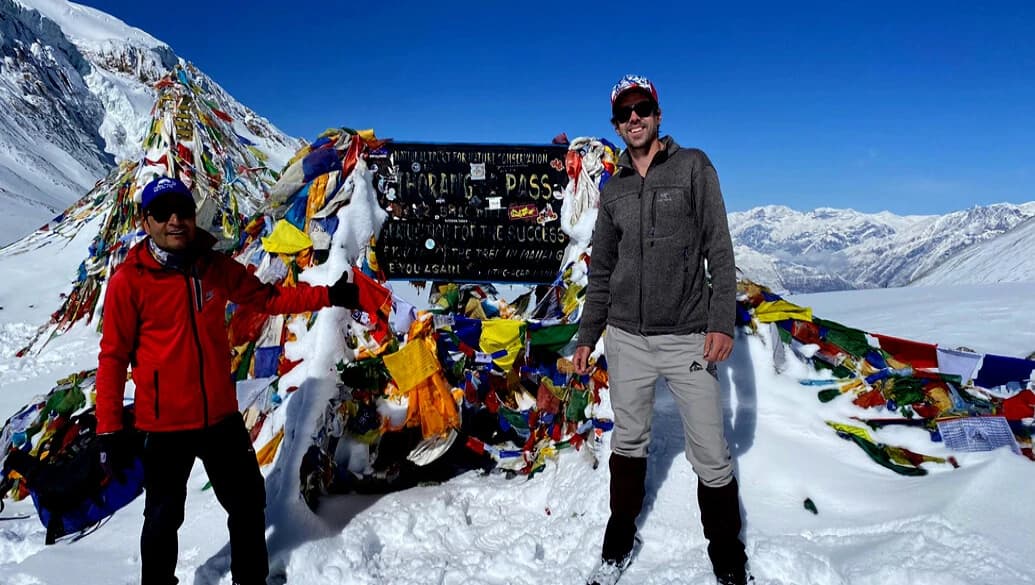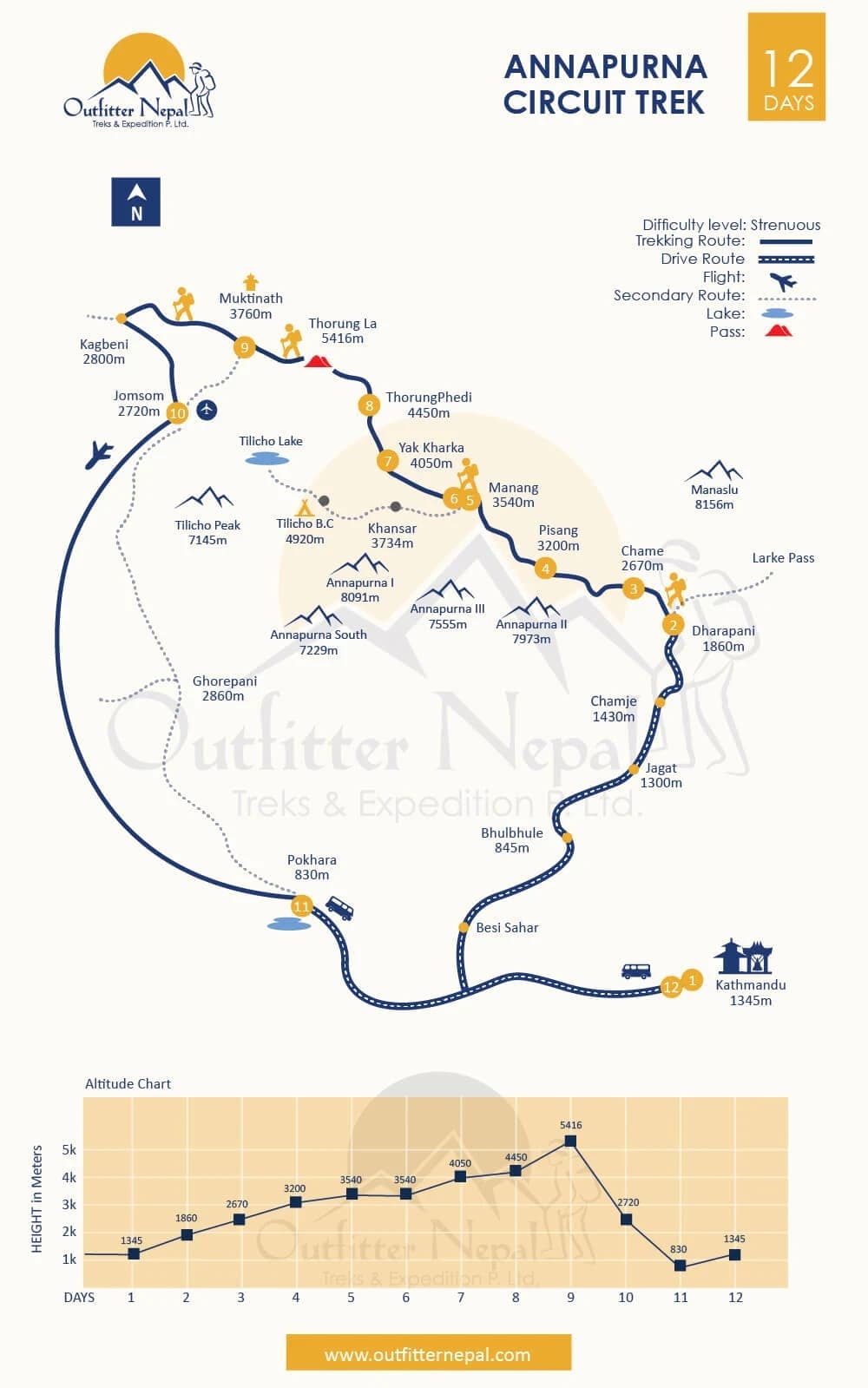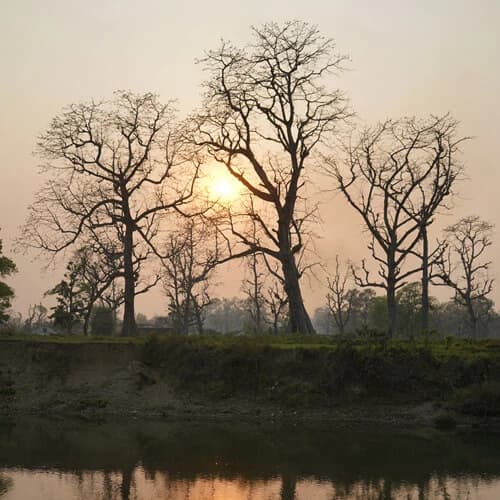Highlights of the Annapurna Circuit Trek 12 Days
- Thorong La Pass (5,416m / 17,756ft): Experience the thrill of reaching the trek's highest point.
- Diverse Landscapes & Ecosystems: The journey transitions from subtropical forests to alpine and glacial regions, including Kali Gandaki, the world’s deepest gorge.
- Rich Cultural Immersion: Exploration of traditional local Nepalese and Tibetan-style villages and the sacred Muktinath Temple (A revered site for Buddhists and Hindus).
- Panoramic Himalayan Views: Magnificent Mt. Annapurna, Nilgiri, Thorung Peak views. Chulu East, Chulu West, Dhaulagiri, Tukuche Peak, Annapurna II, Annapurna IV, and Lamjung Himal.
- Unique Wildlife Encounters: Opportunity to spot various species of plants, flowers, birds, and elusive wild animals like the Blue Sheep.
- Time-Efficient Journey: Complete the classic Annapurna Circuit Trek without missing out on the region's major highlights.
12-Day Annapurna Circuit Trek: A Shorter Itinerary, Unforgettable Views
Since its opening in 1977, the Annapurna Circuit Trek 12 Days in Nepal has become one of the most spectacular trekking routes in the world. It takes travelers to lush green valleys and traditional villages offering mesmerizing views of snow-capped peaks. The Annapurna Circuit Trek blog will guide you through the important details to help you better understand the elements that make this trek a great option for you.
Starting from less than 2,000 meters, the short 12-Day Annapurna Circuit Trek Tour covers the Himalayan region from different perspectives and angles. The journey begins with a scenic drive from Kathmandu to Dharapani along the Marshyangdi River. This magnificent trek leads you to Chame, Pisang, and Manang, inhabited by people from different ethnic groups. The scenery is breathtaking along the way, with stunning Himalayas and desert-like Tibetan Plateaus views.
The Highest point of the Annapurna Circuit Trek 12 Days is at Thorong La Pass (5,416m / 17,756ft). Crossing the pass is challenging and is usually trekked counter-clockwise. While traveling clockwise, the longer ascent and shorter descent are physically exhausting. So, we will be trekking counter-clockwise to the Thorong La Pass and descending westwards to Muktinath temple. We will pass the Kali Gandaki – the world's deepest gorge during the hike. Our remarkable journey comes to an end as we arrive at Jomsom. From here, we will travel to Pokhara and then to Kathmandu.
Note: The construction of the roads in Annapurna Circuit could affect the trek routes in some places. We will do our best to stay updated on their condition and adjust the itinerary for a seamless travel experience.
Why Choose the Annapurna Circuit Trek – 12 Days?
The 12 Days Annapurna Circuit Trek Nepal is ideal for travelers seeking a whole Himalayan experience without committing to a long expedition. It perfectly balances a short itinerary and an entire Himalayan adventure. This journey perfectly fits the Annapurna region's diverse landscape and cultural immersion in a compact time frame. The inclusion of the strategic acclimatization days, well-managed trails and infrastructures along the way, makes the 12-day Annapurna Circuit Trek Nepal beginner-friendly.
The trek begins from Dharapani and ends in Jomsom, avoiding the long and difficult ascents and descents. Additionally, using vehicular drives in the initial and final sections, the itinerary saves valuable trek days without missing out on the core experience. For travelers seeking a beginner-friendly experience of high-altitude trekking, the 12-day Annapurna Circuit Itinerary is an ideal option. It offers safe and convenient travel around the Himalayan massif without having to compromise on the rewards and experience.
Is this 12 Days Annapurna Circuit Trek Suitable for You?
The 12-Day Annapurna Circuit Trek Nepal is suitable for a wide range of trekkers who are physically prepared and are willing to embrace the challenging yet rewarding Himalayan experience. Thanks to its gradual altitude gain and well-structured route, it is a perfect option for beginners who seek a shorter trekking adventure. Please remember that you must be at a moderate to high fitness level to walk 5 to 8 hours daily on varied and often rugged terrains. So, it is important to take periodic rest along the way and make slow and gradual ascent.
Acclimatization is thoughtfully built into the itinerary at Manang, which is crucial for your body to adjust to the elevation gain. It helps you get used to the atmospheric pressure and reduces the oxygen level at higher altitudes. If you are not cautious and do not follow the standard acclimatization procedure, you might be at risk of altitude sickness. For an enhanced trek experience, follow the lead and navigation of our guide. Having said that, if you are at a good fitness level, this trek offers an unforgettable experience of the Himalayas' rich culture and natural beauty.
Note: If you have an underlying medical condition or suffer any physical injuries, it is best to consult your doctor before undertaking the trek.
Is the 12-day Annapurna Circuit Trek difficult?
The Annapurna Circuit Trek Tour is moderately challenging, requiring good physical fitness and mental preparedness. Although it is a shortened version of the whole circuit, including strategic rest stops, it still encompasses significant challenges. Here is a breakdown of what contributes to the overall difficulty of the trek.
- High Altitude: The trek reaches its highest point at Thorong La Pass (5,416 meters/17,756 feet). You will gain significant elevation along the way, posing a risk of Acute Mountain Sickness (AMS).
- Daily Trekking Hours: Travelers should expect to walk around 5 to 8 hours each day on rugged and steep terrains. Some days can be longer and more strenuous than others.
- Weather Conditions: The climate at high-altitude regions during the trek can fluctuate drastically. You might experience occasional rain and snow, and it is crucial to prepare for it with the right gear and equipment.
Note: The trails in the Annapurna Circuit are generally well-marked and maintained. To enhance safety and navigation, it is crucial to travel with a trekking agency and hire an experienced government-licensed guide.
12 Days Annapurna Circuit Trek Cost Details
The 12 Days Annapurna Circuit Trek Cost is depends on the itinerary, facilities, and services included. In general, the package can cost between $800 and $1500. The fee encompasses accommodation, meals, a guide, a porter, permits, transportation, etc. Have a look at the section below to understand what the basic package for the 12-Day Annapurna Circuit Trek includes.





